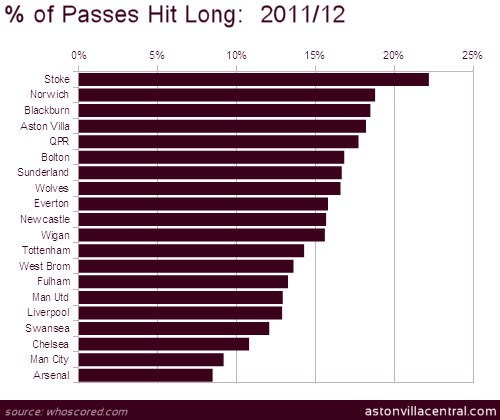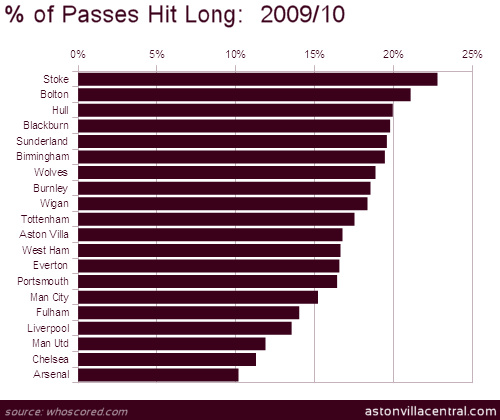HOOF! Long ball statistics over the last three seasons
Written by Dan on November 30, 2011

At the onset of his tenure, it wouldn’t have taken much effort to find predictions about the brand of football Alex McLeish’s Aston Villa side were destined to serve up. None were particularly exciting or encouraging.
I prefer a ‘wait and see’ policy myself, but I think we’re far enough into the season now to look at some statistics and draw some conclusions.
In this post, we’ll focus on the number of attempted passes that have been hit long as a percentage of the total attempted passes during a game on average. The data is sourced from Opta via WhoScored.
We’ll look in a bit more detail at the end of the post, but it’s worth keeping in mind for now that we’ve actually seen the same number of long passes per game on average during 2011/12 as we did during 2009/10 under Martin O’Neill. The difference is the proportion of total passes those long balls represent.
2011/12
Let’s start with the current picture, as of last weekend’s games. Here’s how all 20 Premier League teams shape up when it comes to their preference for the long ball:

No surprise to find Stoke at the top of table, hitting 22.19% of their passes long. They’re pretty consistent too; they were top of the table in 2010/11 with 21.50%, and also in 2009/10 with 22.77%.
The concern, and it will surprise few, is that we’re part of a group of four teams behind Stoke who are all hitting it long more than 17% of the time. In our case it’s 18.21%.
You may be surprised to learn that the leaders when it comes to the actual number of passes hit long per game so far this season are Tottenham and Norwich, both with 74 per game.
2010/11
Would anyone be shocked to find McLeish’s old team leading the pack behind Stoke last season? The only other team to hit more than one in five of their passes long, McLeish’s Birmingham side registered 20.15% on the long ball scale.

Gerard Houllier’s Villa side were in the bottom half with 14.52% of passes hit long, which was an average of 62 per game. Only three sides hit fewer long balls per game; Chelsea (61), Man City (56) and Arsenal (45).
Even Stoke “only” hit 66 passes long per game, but their general lack of possession means those passes represent a high percentage of the total.
The “champion” when it comes to the actual number of passes hit long per game last season was, you’ve guessed it, Birmingham City with 82.
However, it should be noted that Blackpool, a team that won many plaudits for their approach and style of play, gave Birmingham a good run for their money by hitting 80 long balls per game themselves.
Does that last fact, along with Norwich’s position this season, challenge a few perceptions? It probably should.
2009/10
Martin O’Neill’s side were often labelled a “long ball team”, famously by Arsene Wenger on one occasion, and it’s true that he clearly believes in moving the ball from back to front quickly and efficiently. However, I think a distinction can be drawn with McLeish when it comes to purpose and quality. MON certainly sees a greater value in using the flanks.

Again, Birmingham City were near the top of the table, this time hitting it long 19.44% of the time. That’s 76 long passes per game.
Tottenham were kings of the long ball hill in absolute terms though with 79 per game. Roberto Martinez’s Wigan side separated ‘Arry and McLeish with 77 long balls per game.
Again, does this challenge perceptions at all? Were Tottenham a “long ball team” in 2009/10? And if so, who cares, it got them into the Champions League, right?
There’s long ball and then there’s long ball
Not all long balls are equal. For instance, Barry Bannan’s exquisite pass to Marc Albrighton at Craven Cottage last season would be classed as long, but we’d surely watch passes like that all day long. Especially if the net ends up bulging in the same way.

The devil is always in the detail and we could remove the outliers amongst the data if we spent long enough to dive deep enough. However, if you think about the 20 teams on a simple spectrum representing their passing game you’d almost certainly place Stoke at one end and Arsenal at the other.
That’s what this data gives us; the bigger, better quality sides are unsurprisingly closer to Arsenal’s end of the spectrum and the smaller clubs, unable to dominate possession in the same manner, are closer to Stoke. It’s more or less what you’d expect then.
It’s our position on that spectrum which should be of concern. It might also be of concern that McLeish’s Birmingham side resorted to the long ball more frequently in his second Premiership season despite having had more time and money to “build his own team”. It really suggests a modus operandi which is difficult to dispute.
Clues
As we’ve already covered at the top, the 2011/12 version of Aston Villa isn’t hitting any more long balls per game than the 2009/10 version, they just represent a greater proportion of the total passes.
So what’s happened to those other passes?
Here’s how WhoScored breaks down the attempted passes on a per game basis:
| Average number per game | ||||||||
| Season | Crosses | Through Ball | Long | Short | ||||
| 2011/12 | 19 | 5.3% | 1 | 0.3% | 65 | 18.2% | 272 | 76.2% |
| 2010/11 | 26 | 6.1% | 3 | 0.7% | 62 | 14.5% | 336 | 78.7% |
| 2009/10 | 27 | 7.0% | 2 | 0.5% | 65 | 16.8% | 294 | 75.8% |
The number of short passes compared to the last two seasons is alarming enough, but won’t be a massive surprise. What should be of concern is the lack of crosses and through balls as both of those types of passes lead to a goal scoring opportunity.
The combination of crosses and through balls totalled 29 per game in both 2009/10 and 2010/11, but it’s running at just 20 so far this season. That’s a 31% reduction in the type of passes which lead directly to scoring goals.
During 2009/10 we averaged 13.08 shots per game, 4.16 on target, and in 2010/11 it was 13.32 with 4.34 on target per game. This season, we’re down to 11.15 shots per game and just 2.92 on target. It’s frankly astonishing that we’ve actually scored one goal more than at the same point last season.
We’ve got Gabby’s massively improved form, Darren Bent’s deadliness (not withstanding a few sitters missed), and Stiliyan Petrov managing to get a couple of his weekly 30-yarders on target to thank for that.
Shackles
We’ll finish here with a little subjectivity. It may be far from earth-shattering, but it’s my opinion that this side are inhibited by an overly cautious approach. I’m not going to go so far as to call it ‘negativity’ – with the exception of White Hart Lane – but the players are certainly not being encouraged to express themselves.
Full backs are held deep, the lack of true width has been well covered in the past, but surely there’s no bigger anchor to ambition at the moment than plonking Emile Heskey in where we’re crying out for a playmaker. With all due respect to Heskey, natch. Additionally, the silly mistakes gifting possession back to our opponents are surely a sign of tension; a fear of making a mistake. Ironically.
McLeish has described the cameos in Swansea from Barry Bannan and Jermaine Jenas as “food for thought”. I sincerely hope he pigs out. I mean really, really dives in like he’s eating his last meal. Because there’s no shortage of fans who will wish that to be the case, metaphorically speaking of course.
He’s correctly noted the incisive passing from Bannan in particular; the young Scot actually made more key passes than anyone involved despite not getting on the pitch until the 79th minute.
We clearly need more of that, but it will be for nothing if the players are shackled and not allowed to express themselves. The long balls themselves are not the problem so much as there is precious little else.
Please, Mr. McLeish, these players are better than than they’re being allowed to show. Please let them play some football.
Please?